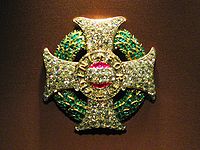This is an old revision of this page, as edited by Xqbot (talk | contribs) at 18:51, 30 April 2010 (robot Modifying: de:Militär-Maria-Theresia-Orden). The present address (URL) is a permanent link to this revision, which may differ significantly from the current revision.
Revision as of 18:51, 30 April 2010 by Xqbot (talk | contribs) (robot Modifying: de:Militär-Maria-Theresia-Orden)(diff) ← Previous revision | Latest revision (diff) | Newer revision → (diff)

The Military Order of Maria Theresa (Militär-Maria-Theresien-Orden in German, Katonai Mária Terézia-rend in Hungarian, Vojenský řád Marie Terezie in Czech, Vojaški red Marije Terezije in Slovenian, Croatian: Vojni Red Marije Terezije) was an Order (decoration) of the Austro-Hungarian Empire founded on June 18, 1757, the day of the Battle of Kolin, by the Empress Maria Theresa to reward especially meritorious and valorous acts by commissioned officer, including and especially the courageous act of defeating an enemy, and thus, "serving" his monarch. It was specifically given for "successful military acts of essential impact to a campaign that were undertaken on own initiative, and might have been omitted by an honorable officer without reproach." This gave rise to a popular myth that it was awarded for (successfully) acting against an explicit order. It is considered to be the highest honor for a soldier in the Austrian Armed services.
Originally, the Order had two classes: the Knight's Cross and the Grand Cross. On October 15, 1765, Emperor Joseph II added a Commander's Cross and a breast star to be worn by holders of the Grand Cross.
A prospective awardee was considered only in regards to their military service record; their ethnicity, birth and rank (as long as he was a commissioned officer) were irrelevant. Knight Cross recipients were automatically ennobled with the title of Ritter in the Austrian nobility for life, and admitted to court. Upon further petition they could also claim the hereditary title of Baron (Freiherr). They were also entitled to a pension. Widows of the Order's recipients were entitled to half of their spouse's pension during the remainder of their lives.
The Order ceased to be awarded by the Austrian Emperor at the fall of the Habsburg Dynasty in 1918, when its last sovereign, Karl I, transferred his powers concerning this honour to the Order Chapter. The Chapter then processed applications until its last meeting in 1931, when it was decided that further awards should not be made. The medal has been awarded a total of 1241 times.
The last surviving knight of the Order was k.u.k. Fregattenleutnant Gottfried Freiherr von Banfield. He received the honour in 1917 for his services as a maritime aviator during World War I and headed the Tripcovich Shipping Company in Trieste after the war. He died in 1986, aged ninety-six.
Insignia
- The badge of the Order was a gilt, white-enamelled cross. The central disc is also in enamel, bearing the coat-of-arms/national flag of Austria, surrounded by a white ring bearing the motto "Fortitvdini" (Fortitude).
- The star of the Order was a silver faceted cross of the same shape as the badge, with a wreath of green-enamelled oak leaves between the arms of the cross. The central disc is the same as on the badge.
- The ribbon of the Order was red-white-red, from the national flag of Austria.
Recipients of the Order:
Major-General Sir Robert Henry Dick, KCB, KCH - 73rd Foot - died of wounds, 10 February 1846. Aged 58. From Tully Mett, Perthshire. Austrian Order of Maria Theresa, Knight of the Russian Order of Vladimir. Fought in Peninsula and Waterloo. Grave at Ferozepore - "Here lies in the hope of joyful resurrection Sir Robert Henry Dick of Tully Mett, Perthshire N.B. Major-General Knight Commander of the Orders of the Bath and of Hanover, Knight of the Austrian Military Order of Maria Theresa and of the Russian Order of Vladimir.
Colonel of H.M. 73rd Regt. For his country he fought & bled: in Egypt at Maida thro'out the Peninsula at Waterloo & in India. For his valour and skill at Fuentes d'onor Busaco Salamanca and Waterloo he received two medals and two honorary clasps. Born on the 29th July 1787 AD he fell in the moment of victory on the 10th Feby 1846 AD while cheering on H.M's 80th Regt having led his division in the assault on the entrenched camp of the Seikh at Sobraon. Honoured and beloved he lived honoured and lamented he died."
Submarine Captain Georg Ludwig von Trapp. Father of the famous Von Trapp family that inspired the movie The Sound of Music. He was given the medal for becoming "the dread of the Adriatic" for using his equipment to the best of his abilities. Born April 4, 1880, he died of lung cancer in Vermont on May 30 1947. He received the Lung Cancer from the toxic fumes emitted from his submarine During WWI. Out of all the medals this one was his favorite, and the only one he was able to smuggle out of Austria.